Abstract
Cell-mediated immunity to Cryptococcus neoformans can be detected by delayed-type hypersensitivity (DTH) to a culture filtrate antigen of C. neoformans. Recently, we have identified a population of cells in spleens of mice immunized with cryptococcal antigen that, when transferred to recipient mice at the time of immunization, amplifies the anticryptococcal DTH response. If the cell donor mice are treated with cyclosporin A during induction of the anticryptococcal DTH response, the amplifier cells are not induced, whereas the cells which transfer DTH (TDH cells) are induced. The purpose of this study was to characterize the amplifier cells with respect to their surface and functional properties and, in so doing, determine whether or not the amplifier cells are analogous to long-lived memory cells. We demonstrated that the amplifier cells were nylon-wool-nonadherent, antigen-specific, CD4 (L3T4+ Lyt-2-) T lymphocytes which appear in the spleens of mice 5 days postimmunization with cryptococcal culture filtrate antigen in complete Freund adjuvant. The amplifier T (Tamp) cells are not considered to be memory cells because they are relatively short-lived, being present 14 but not 18 days after the stimulating immunization. Moreover, the amplified anticryptococcal DTH response does not fulfill the criteria of the typical secondary immune (anamnestic) response in that the amplified response does not appear early relative to the appearance of the primary anticryptococcal DTH response, and it does not persist longer than the primary DTH response. We speculate that Tamp cells are not long-lived memory cells but rather act in a T-helper cell capacity to amplify the anticryptococcal DTH response.
Full text
PDF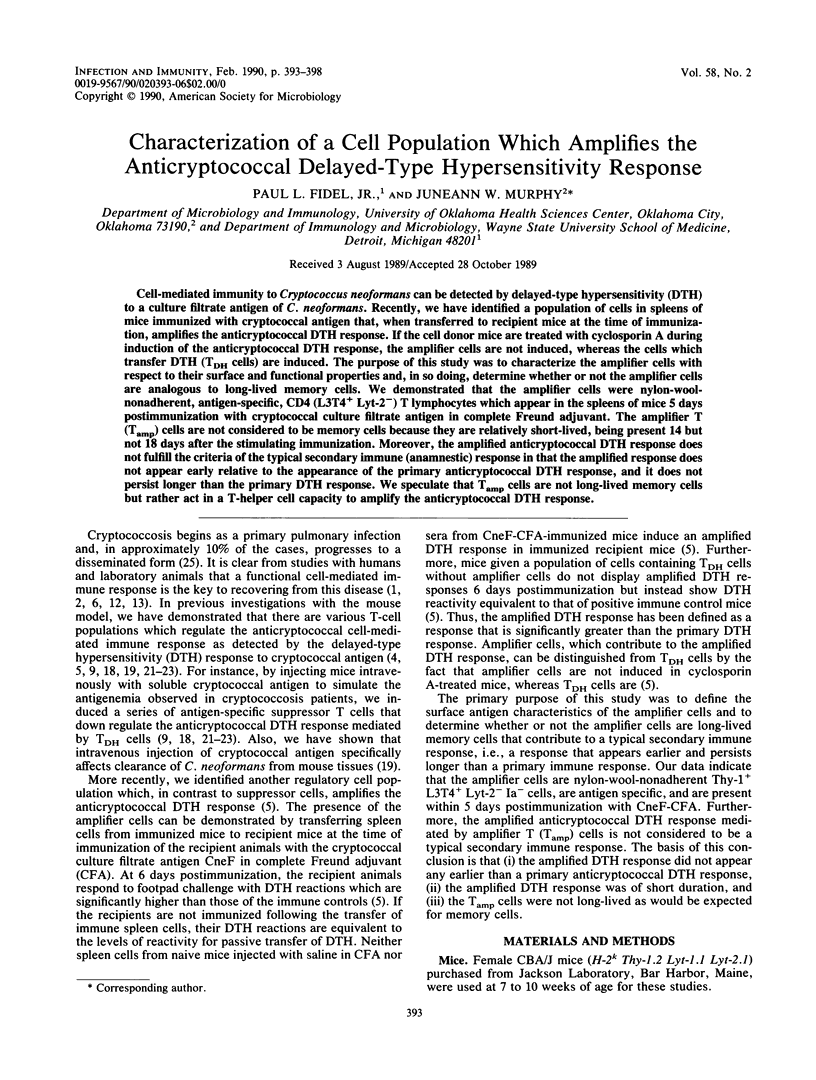
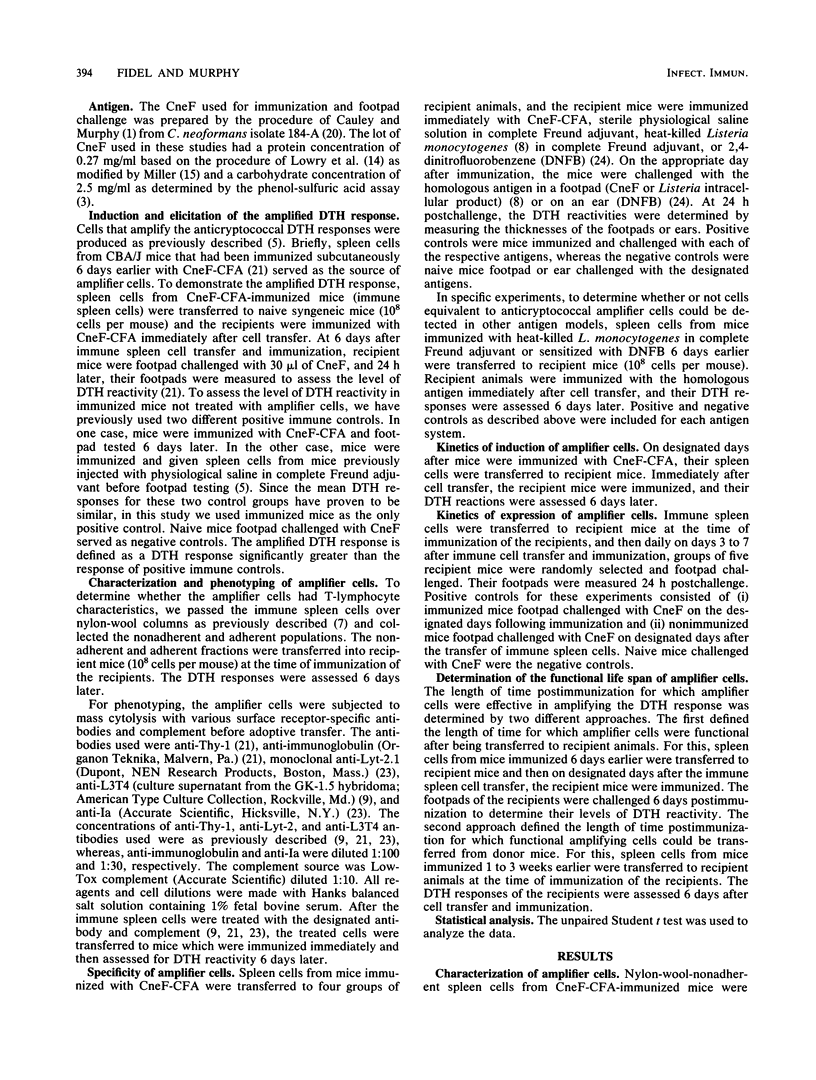
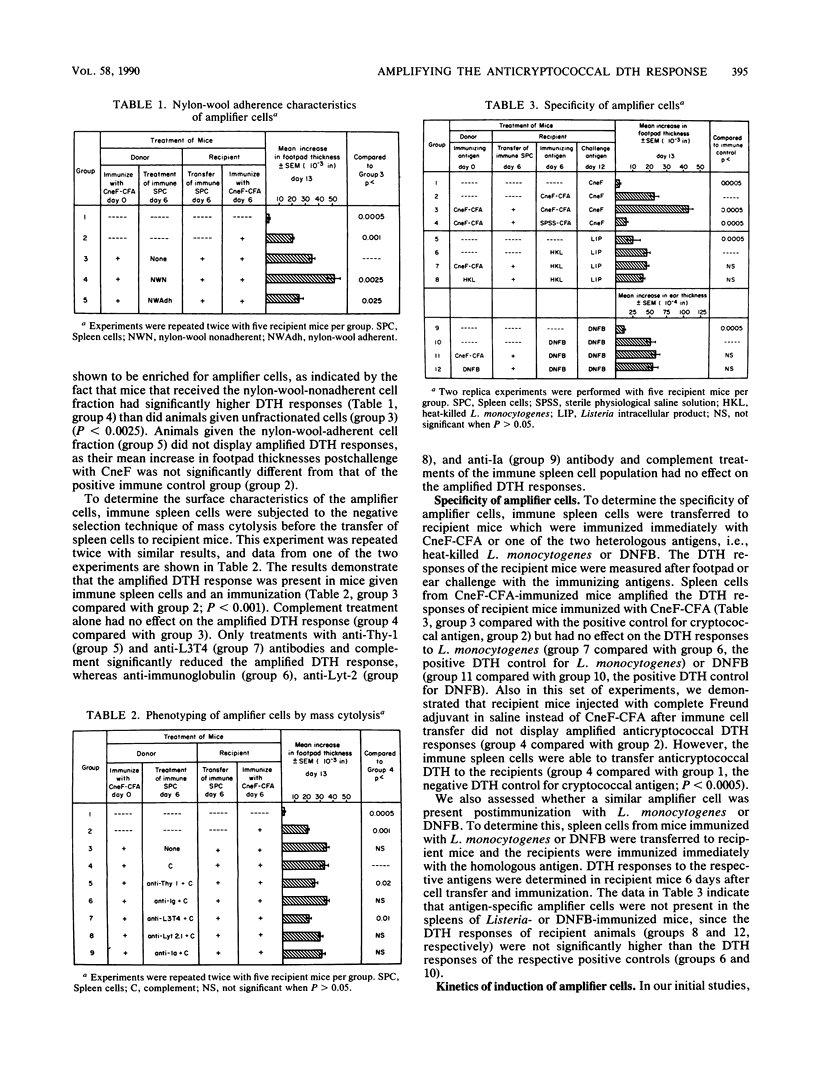
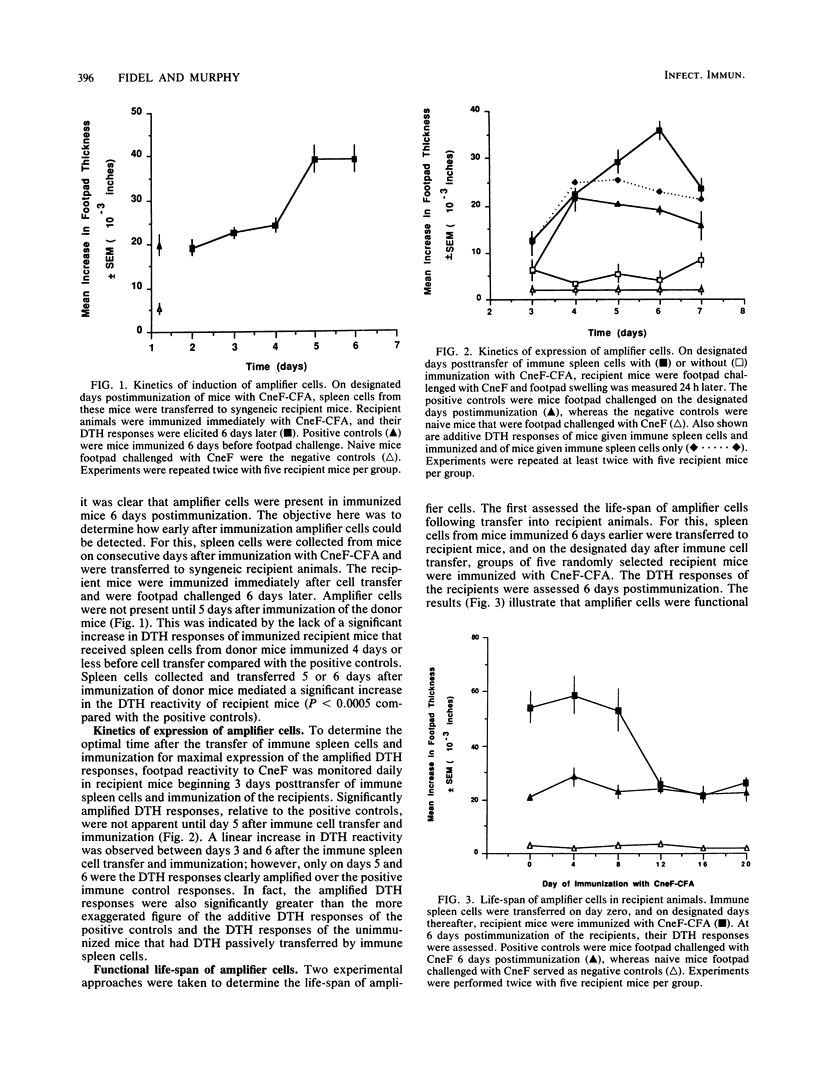
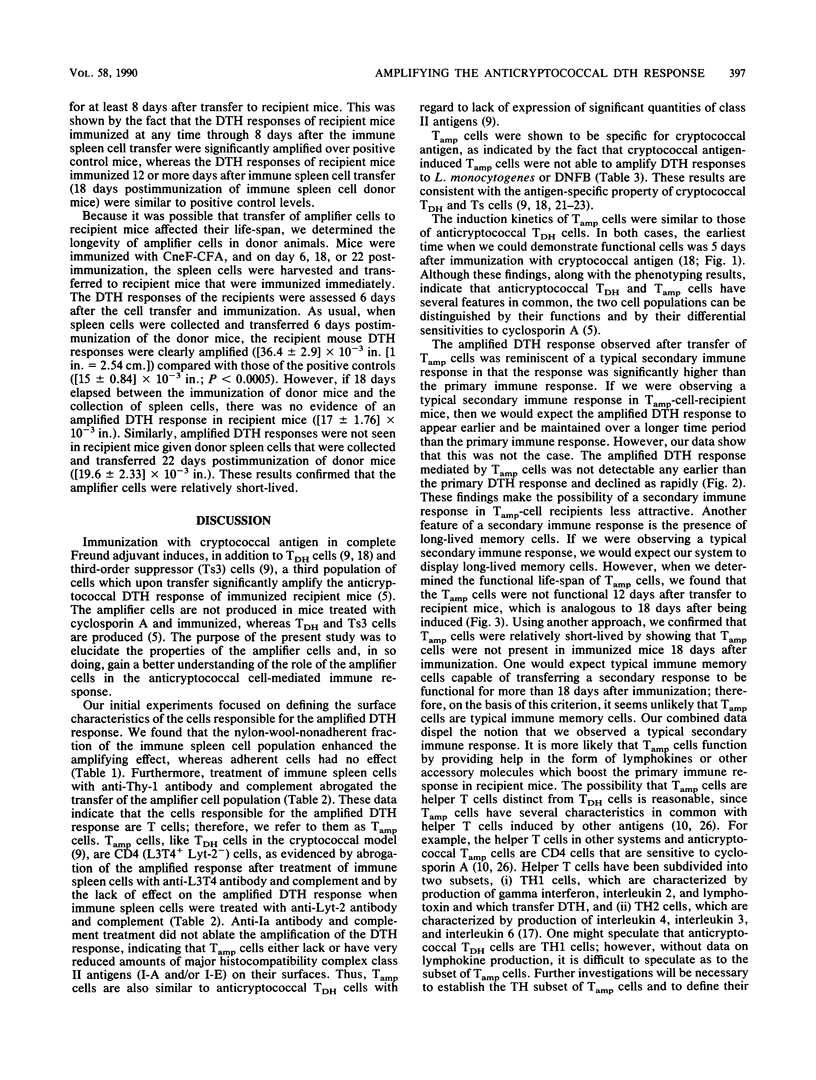
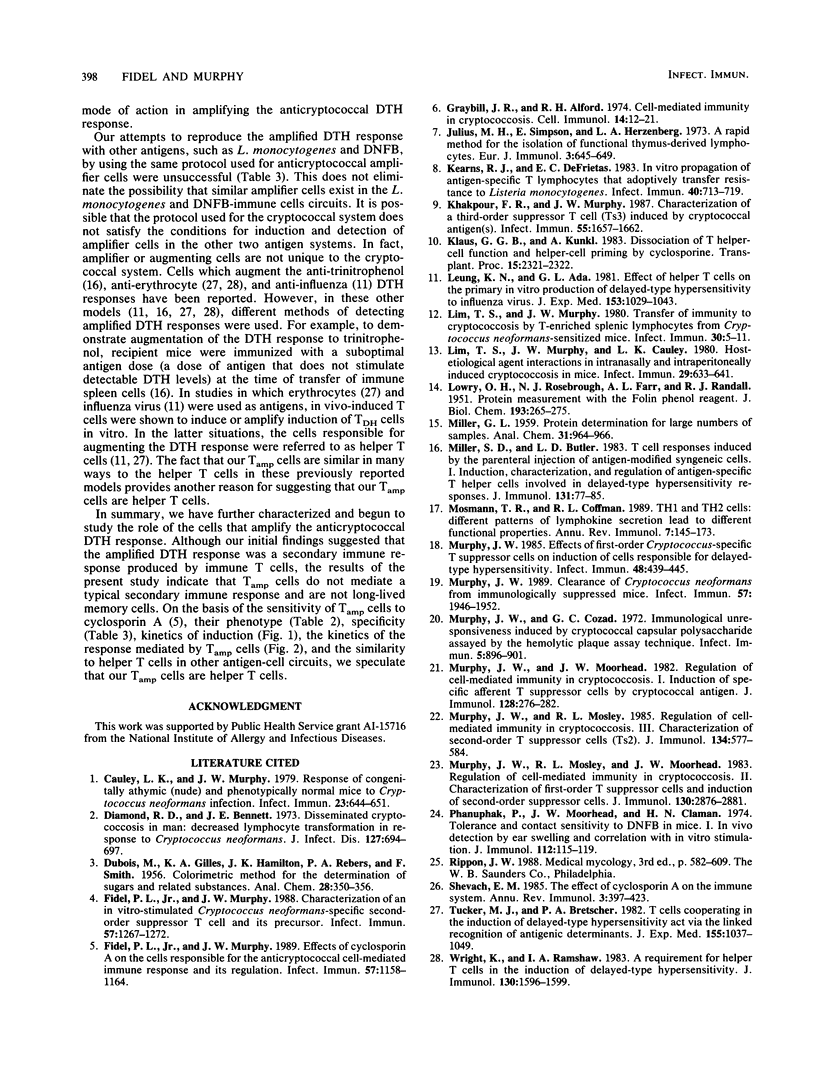
Selected References
These references are in PubMed. This may not be the complete list of references from this article.
- Cauley L. K., Murphy J. W. Response of congenitally athymic (nude) and phenotypically normal mice to Cryptococcus neoformans infection. Infect Immun. 1979 Mar;23(3):644–651. doi: 10.1128/iai.23.3.644-651.1979. [DOI] [PMC free article] [PubMed] [Google Scholar]
- Diamond R. D., Bennett J. E. Disseminated cryptococcosis in man: decreased lymphocyte transformation in response to Cryptococcus neoformans. J Infect Dis. 1973 Jun;127(6):694–697. doi: 10.1093/infdis/127.6.694. [DOI] [PubMed] [Google Scholar]
- Fidel P. L., Jr, Murphy J. W. Characterization of an in vitro-stimulated, Cryptococcus neoformans-specific second-order suppressor T cell and its precursor. Infect Immun. 1988 May;56(5):1267–1272. doi: 10.1128/iai.56.5.1267-1272.1988. [DOI] [PMC free article] [PubMed] [Google Scholar]
- Fidel P. L., Jr, Murphy J. W. Effects of cyclosporin A on the cells responsible for the anticryptococcal cell-mediated immune response and its regulation. Infect Immun. 1989 Apr;57(4):1158–1164. doi: 10.1128/iai.57.4.1158-1164.1989. [DOI] [PMC free article] [PubMed] [Google Scholar]
- Graybill J. R., Alford R. H. Cell-mediated immunity in Cryptococcosis. Cell Immunol. 1974 Oct;14(1):12–21. doi: 10.1016/0008-8749(74)90164-6. [DOI] [PubMed] [Google Scholar]
- Julius M. H., Simpson E., Herzenberg L. A. A rapid method for the isolation of functional thymus-derived murine lymphocytes. Eur J Immunol. 1973 Oct;3(10):645–649. doi: 10.1002/eji.1830031011. [DOI] [PubMed] [Google Scholar]
- Kearns R. J., DeFreitas E. C. In vitro propagation of antigen-specific T lymphocytes that adoptively transfer resistance to Listeria monocytogenes. Infect Immun. 1983 May;40(2):713–719. doi: 10.1128/iai.40.2.713-719.1983. [DOI] [PMC free article] [PubMed] [Google Scholar]
- Khakpour F. R., Murphy J. W. Characterization of a third-order suppressor T cell (Ts3) induced by cryptococcal antigen(s). Infect Immun. 1987 Jul;55(7):1657–1662. doi: 10.1128/iai.55.7.1657-1662.1987. [DOI] [PMC free article] [PubMed] [Google Scholar]
- LOWRY O. H., ROSEBROUGH N. J., FARR A. L., RANDALL R. J. Protein measurement with the Folin phenol reagent. J Biol Chem. 1951 Nov;193(1):265–275. [PubMed] [Google Scholar]
- Leung K. N., Ada G. L. Effect of helper T cells on the primary in vitro production of delayed-type hypersensitivity to influenza virus. J Exp Med. 1981 May 1;153(5):1029–1043. doi: 10.1084/jem.153.5.1029. [DOI] [PMC free article] [PubMed] [Google Scholar]
- Lim T. S., Murphy J. W., Cauley L. K. Host-etiological agent interactions in intranasally and intraperitoneally induced Cryptococcosis in mice. Infect Immun. 1980 Aug;29(2):633–641. doi: 10.1128/iai.29.2.633-641.1980. [DOI] [PMC free article] [PubMed] [Google Scholar]
- Lim T. S., Murphy J. W. Transfer of immunity to cryptococcosis by T-enriched splenic lymphocytes from Cryptococcus neoformans-sensitized mice. Infect Immun. 1980 Oct;30(1):5–11. doi: 10.1128/iai.30.1.5-11.1980. [DOI] [PMC free article] [PubMed] [Google Scholar]
- Miller S. D., Butler L. D. T cell responses induced by the parenteral injection of antigen-modified syngeneic cells. I. Induction, characterization, and regulation of antigen-specific T helper cells involved in delayed-type hypersensitivity responses. J Immunol. 1983 Jul;131(1):77–85. [PubMed] [Google Scholar]
- Mosmann T. R., Coffman R. L. TH1 and TH2 cells: different patterns of lymphokine secretion lead to different functional properties. Annu Rev Immunol. 1989;7:145–173. doi: 10.1146/annurev.iy.07.040189.001045. [DOI] [PubMed] [Google Scholar]
- Murphy J. W. Clearance of Cryptococcus neoformans from immunologically suppressed mice. Infect Immun. 1989 Jul;57(7):1946–1952. doi: 10.1128/iai.57.7.1946-1952.1989. [DOI] [PMC free article] [PubMed] [Google Scholar]
- Murphy J. W., Cozad G. C. Immunological unresponsiveness induced by cryptococcal capsular polysaccharide assayed by the hemolytic plaque technique. Infect Immun. 1972 Jun;5(6):896–901. doi: 10.1128/iai.5.6.896-901.1972. [DOI] [PMC free article] [PubMed] [Google Scholar]
- Murphy J. W. Effects of first-order Cryptococcus-specific T-suppressor cells on induction of cells responsible for delayed-type hypersensitivity. Infect Immun. 1985 May;48(2):439–445. doi: 10.1128/iai.48.2.439-445.1985. [DOI] [PMC free article] [PubMed] [Google Scholar]
- Murphy J. W., Moorhead J. W. Regulation of cell-mediated immunity in cryptococcosis. I. Induction of specific afferent T suppressor cells by cryptococcal antigen. J Immunol. 1982 Jan;128(1):276–283. [PubMed] [Google Scholar]
- Murphy J. W., Mosley R. L., Moorhead J. W. Regulation of cell-mediated immunity in cryptococcosis. II. Characterization of first-order T suppressor cells (Ts1) and induction of second-order suppressor cells. J Immunol. 1983 Jun;130(6):2876–2881. [PubMed] [Google Scholar]
- Murphy J. W., Mosley R. L. Regulation of cell-mediated immunity in cryptococcosis. III. Characterization of second-order T suppressor cells (Ts2). J Immunol. 1985 Jan;134(1):577–584. [PubMed] [Google Scholar]
- Phanuphak P., Moorhead J. W., Claman H. N. Tolerance and contact sensitivity to DNFB in mice. I. In vivo detection by ear swelling and correlation with in vitro cell stimulation. J Immunol. 1974 Jan;112(1):115–123. [PubMed] [Google Scholar]
- Shevach E. M. The effects of cyclosporin A on the immune system. Annu Rev Immunol. 1985;3:397–423. doi: 10.1146/annurev.iy.03.040185.002145. [DOI] [PubMed] [Google Scholar]
- Tucker M. J., Bretscher P. A. T cells cooperating in the induction of delayed-type hypersensitivity act via the linked recognition of antigenic determinants. J Exp Med. 1982 Apr 1;155(4):1037–1049. doi: 10.1084/jem.155.4.1037. [DOI] [PMC free article] [PubMed] [Google Scholar]
- Wright K., Ramshaw I. A. A requirement for helper T cells in the induction of delayed-type hypersensitivity. J Immunol. 1983 Apr;130(4):1596–1599. [PubMed] [Google Scholar]


